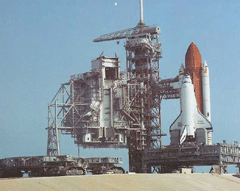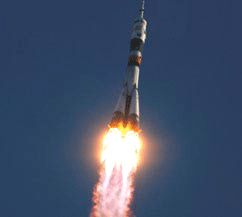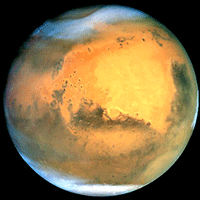Shared Space
Air Date: Week of April 4, 2008

By 2010 shuttle launches like this in the United States will be put on hold until the next generation of shuttles are up and running in 2015. (Photo: NASA)
In two and a half years the United States will decommission the three remaining shuttles capable of taking astronauts to the International Space Station. The only option after that will be to hitch a ride on a Russian shuttle. Neil DeGrasse Tyson, director of the Hayden Planetarium, tells host Bruce Gellerman that such an international collaboration may be just what we need in the space program.
Transcript
GELLERMAN: It’s Living on Earth. I’m Bruce Gellerman. America’s fleet of re-usable space shuttles has been serving the nation for over thirty years now, sending astronauts into low Earth orbit. But in 2010, the remaining U.S. shuttles will make their final landings. The aging fleet is being retired, and it won’t be until 2015 that new capsules and rockets will be ready to send Americans back into space. It’s a five-year missile gap that has some worried that we’ll be dependent on other nations to get us into orbit. But not Neil deGrasse Tyson. He’s the director of the Hayden Planetarium in New York City and our go-to guy on all things space.
TYSON: During this gap, that’s right, we’re going to have to be renting or buying a seat on the Russian Soyus space capsule. We’ve done it before, by the way, but now we’ll have to do it. There will be no other choices to get us to our own space station.
GELLERMAN: Is there a danger in being dependent upon the Russians to provide, you know, the transport to space?

By September 30, 2010 the only way to get to space will be aboard Russian shuttles like the Soyus. (Photo: NASA)
GELLERMAN: What happens, though, if there’s an international crisis? We go toe to toe with the Russians and we don’t get our ride into space.
TYSON: That would be bad, that’s correct. And we could be stranding astronauts up there on the space station. I’d like to think, however -- this may be a little either politically naïve or sort of wishful thinking -- I’d like to think that when you have collaborations on that level that it precludes political conflict because you say to yourselves, 'we are together up there in space, that overrides everything.' It’s been said that space is not about flag waving because, of course, a flag in space doesn’t wave where there is no air….

Neil deGrasse Tyson is director of New York's Hayden Planetarium (Courtesy of Patrick Queen, reprinted with permission of Prometheus Books)
TYSON: …so that might be a lesson for all of us.
GELLERMAN: I remember they used to be talking about the missile gap, back in the sixties. It seems like we’ve got a missile gap and we’re losing the space race then.
TYSON: I don’t think about it just that way because you have to ask, 'well what’s going on here in that five year gap?' What we’re attempting to do is create a next generation launch vehicle that will take our astronauts not only to low Earth orbit, which is where the space shuttle had been going and the space station is, but beyond Earth orbit to the moon, Mars and beyond. And so I don’t think of it as losing a space race, although we will be sort of underserved over that five year period.
GELLERMAN: Well, what about the next generation of manned vehicles for the United States? What is that going to look like?
TYSON: Well, it won’t look like the shuttle, because it doesn’t have the same requirements as the shuttle. This new suite of launch vehicles, which will get to Earth orbit and beyond, have separated the astronauts from the cargo. So, you send the cargo up first and then you send the astronauts up next and they re-dock with the cargo. And in that way you don’t need the same rating on the launch vehicle for the cargo that you would require for the protection of the astronauts. It’s not only safer, it’s more efficient because you can tune the vehicles for exactly their purpose.
GELLERMAN: You know, what’s fascinating is that in my little cell phone that I have in my hand right here, I’ve got more computing power than they had to land the Apollo on the moon.
TYSON: Yeah, it wasn’t quite as bad as like the Flintstones where they were running their feet along the ground.
GELLERMAN: Yabba dabba doo!
TYSON: But it was mostly mechanical operations, yes. And there was some computing power. But that ought to tell you what is possible when we equipped these spacecraft with modern computing and modern hardware and software. So, I have very high ambitions for what our future in space can bring. And by the way, people talk, 'well, why are we spending billions up there when we could be spending it down here?' And then you realize that when we spent billions up there it inspired an entire generation of Americans to become scientists and engineers, which enabled our entire technological revolution that we now all take for granted. It has an effect on the ambitions of an entire nation.
GELLERMAN: There are a number of private companies which have been investigating and investing and experimenting with manned vehicles. How far along are they?

By 2015 the next generation of space shuttles, The Constellation, are expected to take human beings to lower earth orbit, the moon, and even mars. (Photo: NASA)
GELLERMAN: Show me the money.
TYSON: Show me the money, and we don’t remember it that way but because we romanticize the act. But, in fact, we’ve know for a long time that prize money stimulates innovation and creativity. The moment you get the capital markets involved, then you stimulate innovation in ways that would not normally happen in a government-funded project. And when you do so, the hope is that you can get the price of going to space down to something that maybe people can afford that might have otherwise just taken a family trip to Alaska. You get it down into sort of the vacation budget. Take a moon tour or a tour of the hills and valleys of Mars.
GELLERMAN: Well, that, of course, was some of the vision of famous science fiction writer Arthur Clarke who recently died. And his concept of the space elevator, this idea that you could tether, well, basically, have an elevator shaft going to orbit.

By 2010 shuttle launches like this in the United States will be put on hold until the next generation of shuttles are up and running in 2015. (Photo: NASA)
GELLERMAN: Next stop women’s lingerie, toys, men’s wear, the moon.
TYSON: [laughing] There you go. And plus, there’s a friend of mine who’s in the industry who composes music and she composed a CD called Space Elevator Music. Because we’ve got elevator music in buildings. You might as well have one as you’re going into space. So, I look forward to that one being used.
GELLERMAN: Well, Dr. Tyson, it’s always a pleasure. TYSON: Well, thanks for having me.
GELLERMAN: Dr. Neil de Grasse Tyson is director of the Hayden Planetarium in New York City and author of the book "Death by Black Hole and Other Cosmic Quandaries."
Links
Living on Earth wants to hear from you!
Living on Earth
62 Calef Highway, Suite 212
Lee, NH 03861
Telephone: 617-287-4121
E-mail: comments@loe.org
Newsletter [Click here]
Donate to Living on Earth!
Living on Earth is an independent media program and relies entirely on contributions from listeners and institutions supporting public service. Please donate now to preserve an independent environmental voice.
NewsletterLiving on Earth offers a weekly delivery of the show's rundown to your mailbox. Sign up for our newsletter today!
 Sailors For The Sea: Be the change you want to sea.
Sailors For The Sea: Be the change you want to sea.
 The Grantham Foundation for the Protection of the Environment: Committed to protecting and improving the health of the global environment.
The Grantham Foundation for the Protection of the Environment: Committed to protecting and improving the health of the global environment.
 Contribute to Living on Earth and receive, as our gift to you, an archival print of one of Mark Seth Lender's extraordinary wildlife photographs. Follow the link to see Mark's current collection of photographs.
Contribute to Living on Earth and receive, as our gift to you, an archival print of one of Mark Seth Lender's extraordinary wildlife photographs. Follow the link to see Mark's current collection of photographs.
 Buy a signed copy of Mark Seth Lender's book Smeagull the Seagull & support Living on Earth
Buy a signed copy of Mark Seth Lender's book Smeagull the Seagull & support Living on Earth

